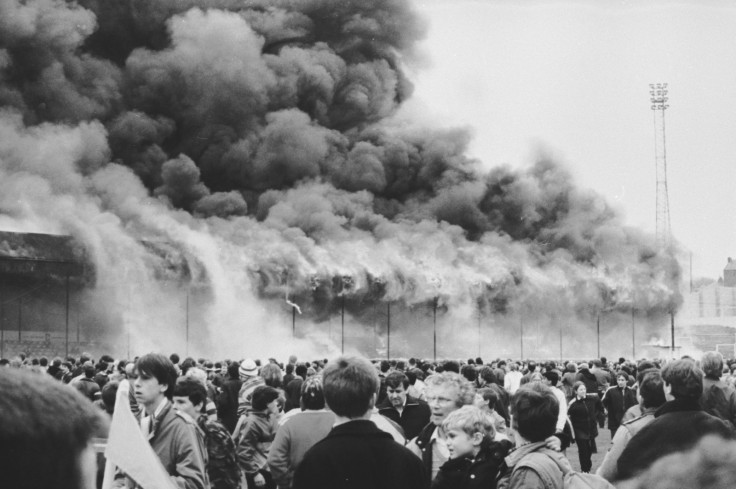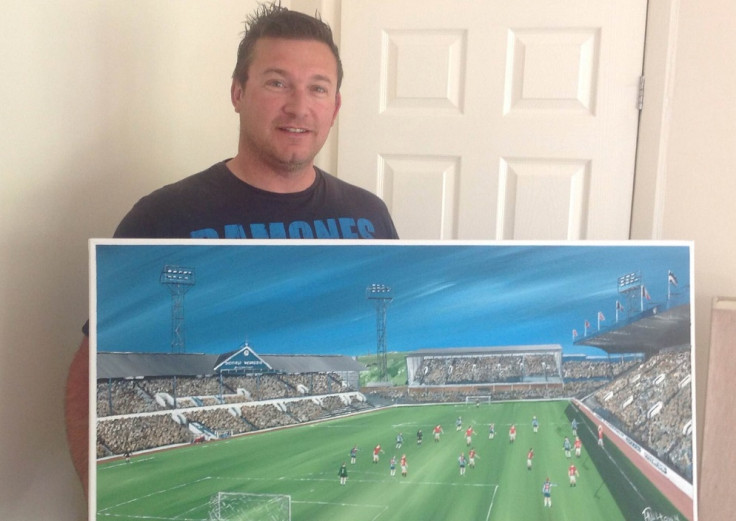Bradford City stadium fire: Remembering the 56 who died at Valley Parade
It was the worst fire disaster in the history of English football.

Fifty-six people were killed, 265 were injured and thousands bore witness to the worst fire disaster in the history of English football. Thirty years on, the majority of survivors still find it too difficult to talk about what happened at the Valley Parade on 11 May 1985.
Mike Harrison, the editor of the Bradford City Football Club fanzine The City Gent, was there on the day.
"I was in the stand opposite when the fire broke out. We sat in the main stand the week before, but we had decided to move on that day," he says. "I was supposed to meet my father at my grandfather's house, but I was a bit late so I went straight to the game so I didn't miss the festivities."
The mood before the match on the 11 May 1985 against Lincoln City was one of jubilation. Bradford City had just won the Third Division Championship and a record number of spectators – over 11,000 – had turned out to see the club presented with its first piece of league silverware in 56 years.
After 40 minutes of the first half, fans had begun to complain about the drab match and the 0-0 score. At 3.40pm, five minutes before half-time, a glowing light was spotted three rows from the back of block G.
"We were stood in line with the 18-yard, the penalty area, when we saw some smoke and a bit of fire diagonally from where we were. We went over to the policeman stood at the corner flag and asked if it was being sorted out, and he said it was under control," Harrison says.
"Since then I have thought of everything we could have done, but we didn't have the presence of mind to run across the pitch and tell people to get out. We didn't know how serious it was."
Spread by the wind, the wooden roof, which was covered with tarpaulin and sealed with asphalt and bitumen, caught fire. Burning timber and molten material began to fall onto the seating below and black smoke enveloped the passageway behind, where fans were trying to escape. No fire extinguishers had been installed over fears of vandalism and less than four minutes after the fire was reported, the fire had engulfed the whole stand.
"It is unbelievable how quickly the fire took hold. People were scrambling for their lives to get out, and I know having sat in that stand normally that it is difficult and there is a drop to get to the pitch level," Harrison says. "We couldn't help because there were so many people streaming towards us, to our side of the pitch, to get away from the heat. From 50 to 60 yards away, it was burning our faces – it was unbearable.
"I remember not being able to watch it, but we couldn't get out. They wouldn't let us because then people would get in the way of fire engines, ambulances and police trying to get in. It was an awful thing to watch."
Those who escaped walked to a nearby pub to use the phone to ring home, while others arrived in a daze outside the police headquarters to try and trace relatives.

Legacy
The fire claimed young and old alike, with most fatalities occurring at the rear of the stand where people sought escape only to find turnstiles locked. Samuel Firth, a founder of the supporters' club, was the oldest victim at 86; four 11-year-old boys were the youngest. The heat was so intense it caused car windows to shatter in the street.
Yet many of those with terrible memories of the tragedy also take heart in the compassion born out of the devastation. Within 48 hours of the disaster, the Bradford Disaster Appeal Fund had been set up and would eventually raise over £3.5m ($5.4m). The plastic surgeon who treated the injuries of over 200, Professor David Sharpe, went on to set up a world-renowned burns research facility at the University of Bradford.
"That was the legacy of the tragedy. It was sort of the good thing to come out of the nightmare," says Simon Parker, a football reporter for the Telegraph and Argus. "It is the little things that show how much people are still involved – the fire still has a big impact on people. It wasn't just something that happened in the past."
Today, locals continue to raise money for the Plastic Surgery and Burns Research Unit in memory of the victims of the fire. At the final home match against Barnsley at the end of April, Bradford City fans collected more than £8,000 in a bucket collection. In the last few years, the BCFC kit-man John Duckworth did a sponsored 73-mile walk between Lincoln's Sincil Bank stadium and Valley Parade, joined by Bradford fans along the way.
"The fire still has a big impact on people," Parker says. "As well as those who lost their lives or were injured, there are the relatives and friends, the others who were at the game, and those who would normally have gone to the match but decided not to that day. Only then do you realise the huge network of people the fire involved."
There has always been a close bond between the club and its supporters since the fire, he adds. "I know it's a cliché to say that, but it's true."

Coming to terms
Witnesses of the fire have come to terms with the tragedy in different ways. Artist Paul Town, who now lives in Baildon, was 15 at the time of the fire. Forty-two minutes into the first half of the game, he looked to his left to see smoke and flames rising from the old wooden seats. A few minutes later, he felt a thump on his back from his father, who told him to run.
"I was in the main stand when the fire happened," he says. "Me and my dad eventually got out safely but it was a bit of a struggle at one point because the walls getting down to the pitch level were quite high – I didn't get a growth spurt until I was 16 or 17."
As he scaled the brick perimeter wall at the front, his father stayed behind to help others escape. When Town reached the Midland Road side of the pitch, he was faced with horrific scenes of the injured being treated and comforted by ambulance crews, fans and players. He started to walk home, unsure of what had happened to his father.
"As a 15-year-old, you don't really know how much of an impact an event like that will have on your life," Town says. "It made me realise life is too short." Luckily, his father arrived home shortly after he did, but 30 years on, he still remembers the young woman who served him a Mars Bar and his father a coffee, who never made it out of the stadium.
Town began to paint two years ago, first of the old Bradford Park Avenue ground, before moving onto other stadiums. His most recent painting is a powerful image; two fans in Bradford and Lincoln City kits, surrounded by 54 other figures. A bid of £350 has been made for the original painting and Town will sell 56 prints in memorial of those who lost their lives, with the aim of raising £3,000 for the Bradford Burns Unit.
"I've always loved art but I owned businesses in construction so I've never had the time or a chance to follow it up," he says. "It's therapeutic and I've met so many people through doing this." Earlier this year, Town gave up working in construction to pursue painting full-time through his business Stadium Portraits.
"I parked my van outside because I started making enough money painting as I was in construction. So I decided to give it that next push. It's a nice little business and it's something positive that came out of a tragedy. It made me realise life is too short and I'm a happier person for it."

Fresh allegations
Most Bradfordians have accepted the fire was a terrible misfortune. Warnings had been issued over the ground's antiquated wooden structure, which had been condemned and was due to be pulled down and replaced with steel and concrete. The Popplewell Inquiry found that a discarded cigarette and an accumulation of litter beneath the stand were to blame.
Yet in 2015, allegations surfaced which shifted the focus to the club's then chairman, Stafford Heginbotham. Martin Fletcher, a Bradford fan who lost three generations of his family in the fire, published a memoir of the tragic event called Fifty-Six – The Story Of The Bradford Fire, in which he claimed the blaze at Valley Parade was one of nine fires at businesses owned by or associated with Heginbotham.
Fletcher, who was 12 at the time of the fire, does not make any direct allegations but he does believe Heginbotham's history with fires – resulting in payouts of around £27m in today's terms – warrants further investigation. "Could any man really be as unlucky as Heginbotham had been?" he asks.
It remains to be seen whether a new investigation will take place. But many, including Harrison, believe it could unnecessarily reopen wounds if it does happen.
"It is hard to imagine how Martin and his mother have managed to cope over the last 30 years and we have always respected him," Harrison says. "But the feeling here is that it is hard to believe that someone would purposefully start a fire. There is no evidence in the book, he is just pointing out there are some coincidences. He asks the reader to make their mind up about whether these fires were a coincidence or not."
Fletcher has been the only survivor to publicly challenge the inquiry's findings. Heginbotham died in 1995, aged 61, and was never prosecuted for the stadium fire, despite the coroner later saying he had given serious consideration to bringing a charge of manslaughter – as the club had failed to act on three separate warnings about a potential fire risk.
At the time, however, Harrison says, Bradford just wanted to move on. "The one thing I remember at the time is we were grateful that we got an answer quickly after the inquiry. We accepted it was an accident, nobody wanted to blame the club because it was the club we wanted to support. The blame was through neglect, they didn't have the money to maintain the stand."
"If the inquiry is opened again, we will await to see what evidence there is to prove is wasn't an accident," he says. "If we were fed a lie about it being an accident, then we will be educated. But I've never spoken to anyone who thought the fire wasn't anything other than a tragic accident."
© Copyright IBTimes 2024. All rights reserved.






